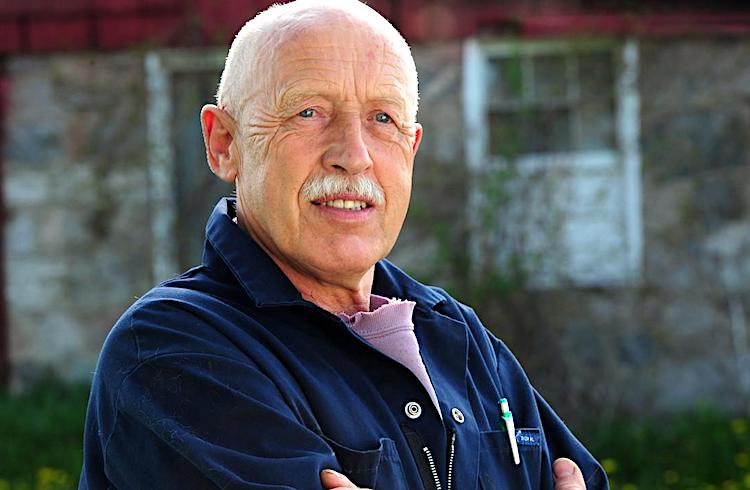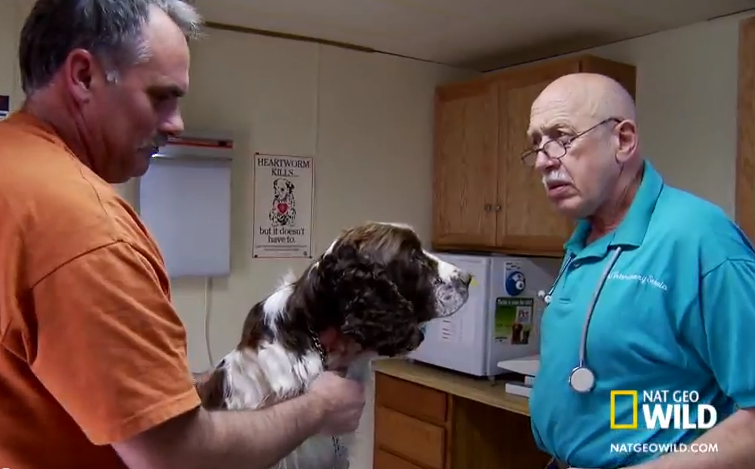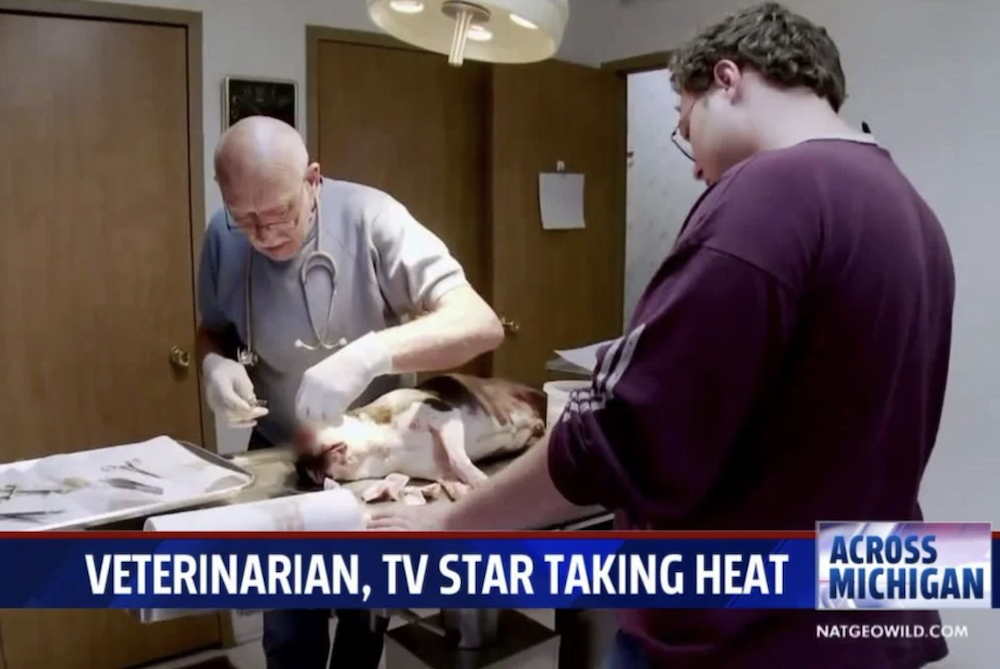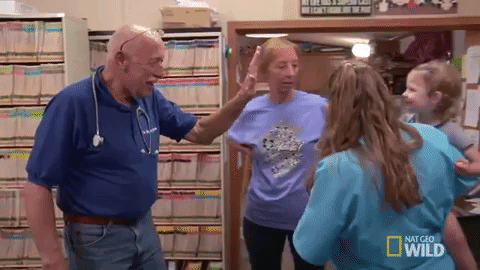
A few years ago, my technician said to me, “Hey, are you watching this vet on TV — Dr. Pol? How in the world is he getting away with this stuff?”
She was talking about The Incredible Dr. Pol on Nat Geo WILD. A lot of my colleagues felt that this wildly popular show should actually be named “The Incompetent Dr. Pol.”
In 2012, Dr. Jan Pol, DVM, was fined and placed on probation for an incident involving a pregnant dog.
Then, in 2015, arising from a separate incident, the state medical board once again found him negligent, asserting that he was guilty of not meeting required minimum standards of veterinary care.
The Dr. Pol controversy was in full swing.
Ultimately, the second decision was reversed by an appeals court. Even so, the controversy surrounding Dr. Pol rages on.
Keep reading, and I’ll explain why so many of us in the veterinary field remain highly critical of this reality TV vet.

Who Is Dr. Pol?
The incredible, or incompetent, Dr. Pol (depending on which camp you’re in) is a mixed-animal veterinarian in rural Michigan, and he has been a star in the world of reality television since 2011.
Now in his late 70s, Dr. Pol has been practicing just the way he did when he arrived in the United States from the Netherlands in 1970. He calls it “common-sense veterinary medicine.”
He was a large animal vet and practiced exclusively on cows for years.
Based on his bio and his TV show, I have no idea where or when he tried to become proficient in small animal medicine.
The show takes him through his long days out on farms treating horses and cows, as well as back in the clinic seeing small animals.
Dr. Pol Controversy
Many people who watch his show love Dr. Pol because they think “old-school” means caring about animals and not charging a lot of money to do what he loves.
Well, I’m a bit old-school, I love my patients, and my clients’ pocketbooks are never far from my mind.
In terms of pricing, I have been told by a number of veterinary business consultants that my prices are too low.
Be that as it may, my gripe with Dr. Pol is that “low prices” never has to mean substandard care or unnecessary deaths. Dr. Pol may look like the wonderful ol’ family farm vet, but his medicine is completely outdated.
He could be compassionate and considerate of people’s finances, leave all the bells and whistles behind, but understand that animals have a pain center and that surgery requires clean gloves.
Was YOUR Pet Food Recalled?
Check Now: Blue Buffalo • Science Diet • Purina • Wellness • 4health • Canine Carry Outs • Friskies • Taste of the Wild • See 200+ more brands…

Let me give you some controversial examples from the show’s early seasons:
- A dog’s tail is amputated without proper anesthesia or sterile technique.
- A dog’s femoral head (top of rear leg bone) is cut off without proper pain medication and sterile technique.
- A mauled puppy is placed in a cage and dies.
- A dog who probably had a ball stuck in its GI tract dies without the benefit of hydration or surgery.
- A Boston Terrier’s eye is removed without sufficient anesthesia, pain meds, sterile technique or intubation (that is, anesthesia delivered via a tube down the trachea so this brachycephalic dog can breathe). These dogs have enough trouble breathing when they’re awake!
Those are just a few sad cases that should not be happening these days. Dr. Pol’s fans believe his kind of veterinary medicine is acceptable because he isn’t a high-faluttin’ city vet who costs a ton of money.
Here’s the thing, though: Basic standard veterinary practices don’t have to cost a lot of money.
I’m not saying every animal needs state-of-the-art monitoring systems, referrals to pricey veterinary centers, etc.
But every animal, if not in a war zone or undeveloped country, deserves proper anesthesia and pain control, sterile surgical technique — and, most important of all, a chance at survival.
“Cheap” Can Actually Mean Big Profit Margin
Let’s take one example from an early season of The Incredible Dr. Pol: the tail amputation.
Dr. Pol performed surgery on this dog without minimal acceptable sterile technique, with limited anesthesia and pain medication. Could he have done this a better way and still charge very little? You bet.
Here’s how he could have done the surgery in a cost-effective way:
- Anesthetize the dog on an anesthetic machine, providing oxygen and respiratory support. (Cost: $50–100 for 1/2 hour of general anesthesia)
- Use sterile technique. (Cost: One large latte. Or a Danish.)
- Dispense proper pain medication. (Cost: Two large lattes.)
Basic anesthetic and cleanliness protocols are not hoity-toity veterinary medicine. Every pet deserves a chance to have pain controlled and not develop a nasty infection because of a dirty surgical procedure.
Do you know what old-time practitioners like Dr. Pol usually do?
They cut corners on safety and still charge their clients enough to make a nice profit.
And the clients don’t know any better. They think they’re getting a “deal” from the friendly old no-nonsense veterinarian, while Ol’ Doc Dirty Hands is skipping all the way to the bank.
A worse case may be that old-timers like Dr. Pol really don’t know any better. Ignorance may be a worse offense.
Dr. Pol’s age is no excuse. I have colleagues in their advanced years who have kept up with the changing face of veterinary medicine and are role models and mentors for younger vets. Combine their quest for new knowledge with their years of experience and they are great assets to the profession.
Sanctioned by the State Veterinary Board
Now let’s return to those legal battles I mentioned earlier:
2010 Complaint — $500 Fine and 1-Year Probation
The first complaint was filed against Dr. Pol by a client in 2010 for giving poor advice and misdiagnosing dead puppies via ultrasound. The client had made multiple phone calls to Dr. Pol, complaining that her pregnant dog, Mocha, had passed her due date and was exhibiting a vaginal discharge.
The phone calls were not documented, something all veterinarians can be guilty of. But when Dr. Pol and his associate performed an ultrasound days later, Dr. Pol claimed he saw movement from the puppies when, it seems, the 10 puppies were already dead.
In 2012, Dr. Pol and his veterinary associates were found to be negligent, fined, placed on probation and ordered to complete some continuing education.
In its decision, the Michigan Board of Veterinary Medicine found that “Pol’s failure to accurately read the ultrasound, perform a C-section, and to maintain records on Mocha was evidence of negligence, or failure to exercise due care,” according to dvm360.
The board found that Dr. Pol had failed to conform to minimum standards of acceptable and prevailing practice for the health profession.
Nat Geo WILD tried to spin the outcome, stating that the fine was merely for an “administrative complaint, not malpractice or misdiagnosis.”

2014 Complaint — Overturned on Appeal
The second complaint came in 2014 from a TV viewer, a veterinarian herself.
Dr. Eden Myers, DVM, said she watched in horror as a Boston Terrier named Mr. Pigglesworth was operated on by Dr. Pol and his son without sterile surgical attire or sterile draping.
Her complaint said, in part:
“Dr. Pol did the surgery of taking Mr. Pigglesworth’s eye out dressed in what looked like the same shirt he’d carried him down to X-ray in. He didn’t put on a gown or a surgical cap and mask for the surgery, or use a drape for the surgical site. He did the surgery with instruments that were laying on a paper towel. He used more paper towels during surgery to dab at the eye and the eye socket. Throughout the surgery Mr. Pigglesworth was laying on the bare steel table. They didn’t even put a towel under him.”
In 2015, the Michigan state board found Dr. Pol guilty of negligence and incompetence in the treatment of Mr. Pigglesworth, ordering the controversial vet to once again pay a $500 fine and go on probation for 1 year.
Dr. Pol’s son, Charles, blasted the board’s decision, pointing out that “Mr. Pigglesworth is perfectly fine [and] his owners are more than happy with the care and treatment that Dr. Pol provided.”
It wasn’t long before Dr. Pol was vindicated — in 2016, an appeals court overturned the disciplinary action. The appeals court judges, finding 3–0 in favor of Dr. Pol, called the board’s disciplinary action “arbitrary and capricious.”
Dr. David Carser, BVSC, who is both a veterinarian and a lawyer, believes the appeals decision was justified because in Michigan there’s no actual law mandating that vets perform sterile surgery.
“The court found there is no actual legal requirement in Michigan that determines a veterinarian must carry out surgery in a sterile environment, wear surgical gloves, a gown, a mask, and a cap during surgery, provide intravenous therapy, use specific types of anesthesia, or provide specific forms of postoperative treatment or nursing,” says Dr. Carser.
“Therefore, the court found that there is no basis in law on which to establish a violation when these are not followed.”

Final Thoughts on the Dr. Pol Controversy
We veterinarians have a tough job.
Sounds like I’m having a little pity party, but it’s true. We need to do the best job possible diagnosing and treating the pet, explaining all options to families, and adhering to a professional standard of care, all while being transparent and honest with the families about costs, prognosis and so on.
Whew! No wonder I’m exhausted after doing those very things 10–20 times a day.
So when someone like Dr. Pol is on television representing the profession in a substandard professional light, it makes many of us veterinarians sad.
 This pet health content was written by a veterinarian, Dr. Debora Lichtenberg, VMD. This article was originally published in 2012 and is regularly updated. It was last reviewed for accuracy and updated Aug. 3, 2019.
This pet health content was written by a veterinarian, Dr. Debora Lichtenberg, VMD. This article was originally published in 2012 and is regularly updated. It was last reviewed for accuracy and updated Aug. 3, 2019. 

